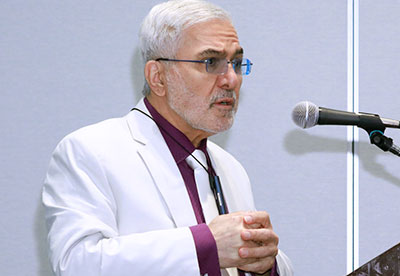Simpler Blood Monitoring, Sharing Clinical Experiences Critical to Expanding Clozapine Use

The availability of quick, easy-to-use, point-of-care blood tests should help increase the use of clozapine, said a panel of experts during an Annual Meeting session on clozapine underutilization. However, the rigorous blood monitoring required to check for clozapine-associated neutropenia is just one barrier limiting the medication’s use, they noted. Psychiatrists’ hesitancy and lack of experience using the effective schizophrenia treatment are even greater barriers.
Speaking to a packed house, investigators Dan Siskind, Ph.D., M.B.B.S., an associate professor of psychiatry at the University of Queensland in Australia; Dan Cohen, M.D., Ph.D., of Mental Health Care North-Holland in the Netherlands; Henry Nasrallah, M.D. (pictured above), of St. Louis University School of Medicine; and Jonathan Meyer, M.D., of the University of California, San Diego, shared their experiences prescribing clozapine and discussed available resources in an effort to help expand use of this proven medication for treatment-resistant schizophrenia.
Cohen touched on an issue that many psychiatrists fret over: the requirement of monthly blood tests to monitor drug levels and ensure that patients taking clozapine do not exhibit a rapid loss of white blood cells (neutropenia), which can endanger their health. Many clinics may be hesitant to prescribe clozapine because of costs and time involved in blood monitoring. Cohen highlighted two approaches to simplify this process.
The first is the use of tabletop, point-of-care blood tests that use a finger prick to collect capillary blood (as opposed to venous blood draws) to quickly assess samples. Cohen conducted a survey study of 70 patients who reported that capillary blood drawing was more convenient and tolerable than traditional blood drawing. It’s also more cost-effective, he noted. His study involved a device developed by Swedish company Hemocue, and the panel pointed out that U.S. company Athelas received FDA approval last year for a point-of-care white blood cell test.
Another cost-effective approach uses dried blood spot sampling, as is done to test for metabolic disorders in newborns. While dried blood spot sampling can assess clozapine drug levels only to determine whether the patient is in a therapeutic range, the test involves a pinprick and some filter paper to collect blood, which can then be sent to a laboratory for analysis.
While neutropenia receives a good deal of attention, the panelists and session attendees highlighted other rare but significant side effects associated with clozapine including myocarditis (inflammation of the heart muscle), constipation, and excess drooling.
But lack of knowledge and experience with clozapine remain key contributors to clozapine's underutilization. And technology won’t be the magic solution for this, Siskind noted. He encouraged psychiatrists with clozapine experience to share their knowledge with others whenever possible and to get others—including nurses, other clinical staff, even patients—involved in the process as well. “If we can get current users to discuss their experiences, the good and the bad, it could help convince many others,” he said.
As one example of a clozapine-users network, Nasrallah talked about his CURESZ (Comprehensive Understanding via Research and Education into Schizophrenia) Foundation. He established CURESZ in 2016 alongside Bethany Yeiser, a patient of Nasrallah’s who went from homelessness to full recovery with the help of clozapine. In addition to providing educational lectures about schizophrenia to young adults across the nation, CURESZ has established an international panel of clozapine experts to help guide physicians and their patients. Any physician can access the CURESZ website to find the nearest expert for assistance and potential referral.
Meyer then highlighted a book he recently co-authored that serves as a comprehensive clozapine therapy resource for physicians. “I felt the field needed this more than anything. For all the years clozapine has been used, there has only been one previous textbook on the subject,” he said. And, unfortunately, that previous book quickly became outdated as the clozapine blood-monitoring guidelines were changed right after it was published.
“The clinical evidence is there,” Siskind said in conclusion of his talk. “Clozapine reduces hospitalizations, it reduces mortality, patients like to take it, and it saves hospitals money. We just need to convince providers to overcome their worries about lack of experience and give clozapine a shot.”
(Image: David Hathcox)
|
|
|
|
Advertisement

|
|
 |
|
|


